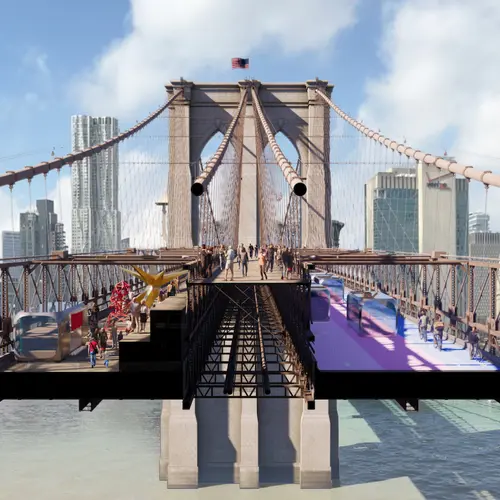See the design proposals that would make the Brooklyn Bridge a pedestrian oasis

“Back to the Future,” Bjarke Ingles Group and Arup
The coronavirus pandemic has highlighted the importance of public space, especially in a city like New York, where residents lack private backyards and most common spaces are too narrow for proper social distancing. A design contest launched earlier this year looking for ideas on how to improve the overcrowded pedestrian promenade of the Brooklyn Bridge, where thousands of walkers and cyclists fight for space daily. The Van Alen Institute and the New York City Council on Thursday announced the six finalists for the “Reimagining Brooklyn Bridge” design contest, with selected proposals calling for less space for cars and more for people.
The contest sought proposals that “balance the needs of the bridge’s many users, honor the bridge’s place among New York’s treasured landmarks, and inspire civic design in our city for generations to come,” according to the design brief.
The two finalist categories consist of three finalists 22 years of age and older (who will receive $13,000) and three finalists under 21 (who will receive $3,000). One winner will ultimately be selected from each category after finalists present proposals in a virtual “Design Showdown” on July 23. The public and the competition jury will be able to offer feedback and then cast votes online between July 23 and July 30.
Bjarke Ingels of Bjarke Ingels Group and Arup are among the finalists, with their design “Back to the Future.” According to the architects, this proposal would “return the bridge to its original state both architecturally and functionally” by removing cars and ramps. With more space for people, bikes, and transit, the bridge would create a better connection between Downtown Brooklyn and Lower Manhattan.

“Bridge X,” ScenesLab, Minzi Long, and Andrew Nash
“Bridge X”—a design proposal from ScenesLab, Minzi Long, and Andrew Nash–reimagines the upper and lower decks of the bridge as space for pedestrians and cyclists. The design would also take into consideration street vendors and small businesses, which the city has previously tried to restrict where they could sell. The new plan would offer digital tools for visitors to engage with the historic infrastructure.

“Brooklyn Bridge Forest,” Scott Francisco of Pilot Projects Design Collective
Another finalist selected is Scott Francisco of Pilot Projects Design Collective and his design “Brooklyn Bridge Forest,” which aims to improve overall mobility on the bridge. The wooden pedestrian walkway would be expanded with planks sourced from a partner community in Guatemala, according to the designer.
“A dedicated bike path and reclaimed traffic lane create new space for cyclists and low-carbon transit, while biodiverse ‘microforests’ at either end of the bridge serve as green spaces,” according to the press release.

“Do Look Down,” Shannon Hui, Kwans Kim, and Yujin Kim
Making the Brooklyn Bridge an even more Instagramable-attraction, a design from Shannon Hui, Kwans Kim, and Yujin Kim involves the installation of a glass surface above the bridge’s girders, lending to the project’s name of “Do Look Down.” The lower roadway would feature space for vendors and performers. The design also calls for kinetic paving, which could include an LED and projection system “to honor the city’s cultures, histories, and identities.”

“The Artery,” Lukas Kugler
In Lukas Kugler’s design, the bridge would feature designated spaces for vendors with three separate pathways for cyclists, runners, and pedestrians. “The Artery” aims to create a “contiguous modern transportation corridor” between the two boroughs, according to the designer. Native plants and wildlife would also be incorporated onto the bridge as natural borders between the three paths.

“The Cultural Current,” Aubrey Bader and Maggie Redding
Aubrey Bader and Maggie Redding’s “The Cultural Current” proposal includes colorful paths and cultural markers that would create a “fluid integration of surrounding neighborhoods into a transportation and public space network” across the bridge. The plan also calls for a phase-out of car traffic on the lower roadway.
“With six lanes for traffic and one narrow, cramped right-of-way that pedestrians and cyclists must share, it’s clear that we haven’t been making the best use of the Brooklyn Bridge,” Danny Harris, executive director of Transportation Alternatives and one of the competition’s jurors, said in a press release. “This design competition will expand the conversation about how to unlock this critical link, and as advocates fighting for a bike- and pedestrian-focused future, we’re glad to be a part of it.”
Register for the virtual Design Showdown here.
RELATED:

































